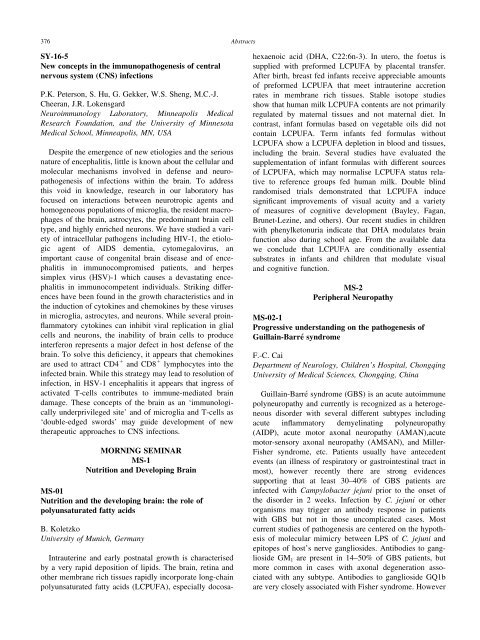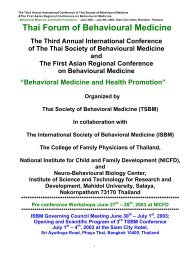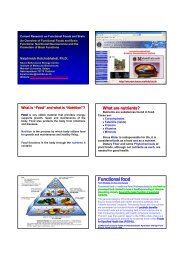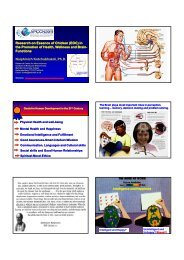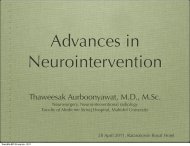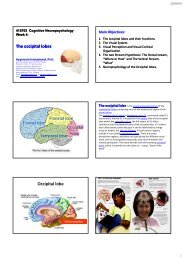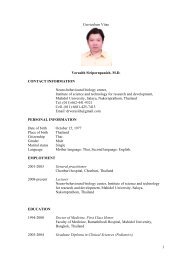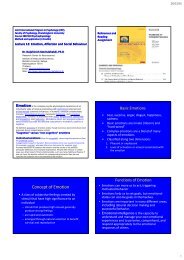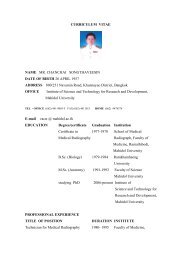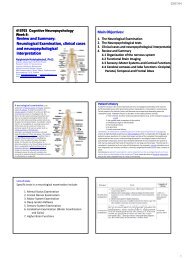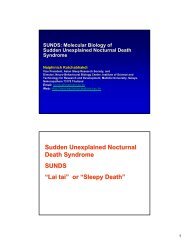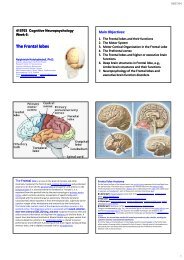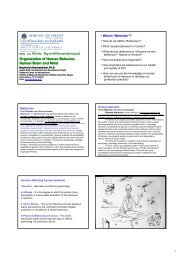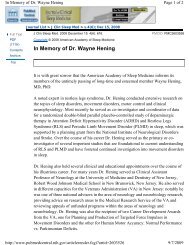PDF File - Mahidol University
PDF File - Mahidol University
PDF File - Mahidol University
Create successful ePaper yourself
Turn your PDF publications into a flip-book with our unique Google optimized e-Paper software.
376<br />
Abstracts<br />
SY-16-5<br />
New concepts in the immunopathogenesis of central<br />
nervous system (CNS) infections<br />
P.K. Peterson, S. Hu, G. Gekker, W.S. Sheng, M.C.-J.<br />
Cheeran, J.R. Lokensgard<br />
Neuroimmunology Laboratory, Minneapolis Medical<br />
Research Foundation, and the <strong>University</strong> of Minnesota<br />
Medical School, Minneapolis, MN, USA<br />
Despite the emergence of new etiologies and the serious<br />
nature of encephalitis, little is known about the cellular and<br />
molecular mechanisms involved in defense and neuropathogenesis<br />
of infections within the brain. To address<br />
this void in knowledge, research in our laboratory has<br />
focused on interactions between neurotropic agents and<br />
homogeneous populations of microglia, the resident macrophages<br />
of the brain, astrocytes, the predominant brain cell<br />
type, and highly enriched neurons. We have studied a variety<br />
of intracellular pathogens including HIV-1, the etiologic<br />
agent of AIDS dementia, cytomegalovirus, an<br />
important cause of congenital brain disease and of encephalitis<br />
in immunocompromised patients, and herpes<br />
simplex virus (HSV)-1 which causes a devastating encephalitis<br />
in immunocompetent individuals. Striking differences<br />
have been found in the growth characteristics and in<br />
the induction of cytokines and chemokines by these viruses<br />
in microglia, astrocytes, and neurons. While several proinflammatory<br />
cytokines can inhibit viral replication in glial<br />
cells and neurons, the inability of brain cells to produce<br />
interferon represents a major defect in host defense of the<br />
brain. To solve this deficiency, it appears that chemokines<br />
are used to attract CD4 1 and CD8 1 lymphocytes into the<br />
infected brain. While this strategy may lead to resolution of<br />
infection, in HSV-1 encephalitis it appears that ingress of<br />
activated T-cells contributes to immune-mediated brain<br />
damage. These concepts of the brain as an ‘immunologically<br />
underprivileged site’ and of microglia and T-cells as<br />
‘double-edged swords’ may guide development of new<br />
therapeutic approaches to CNS infections.<br />
MORNING SEMINAR<br />
MS-1<br />
Nutrition and Developing Brain<br />
MS-01<br />
Nutrition and the developing brain: the role of<br />
polyunsaturated fatty acids<br />
B. Koletzko<br />
<strong>University</strong> of Munich, Germany<br />
Intrauterine and early postnatal growth is characterised<br />
by a very rapid deposition of lipids. The brain, retina and<br />
other membrane rich tissues rapidly incorporate long-chain<br />
polyunsaturated fatty acids (LCPUFA), especially docosahexaenoic<br />
acid (DHA, C22:6n-3). In utero, the foetus is<br />
supplied with preformed LCPUFA by placental transfer.<br />
After birth, breast fed infants receive appreciable amounts<br />
of preformed LCPUFA that meet intrauterine accretion<br />
rates in membrane rich tissues. Stable isotope studies<br />
show that human milk LCPUFA contents are not primarily<br />
regulated by maternal tissues and not maternal diet. In<br />
contrast, infant formulas based on vegetable oils did not<br />
contain LCPUFA. Term infants fed formulas without<br />
LCPUFA show a LCPUFA depletion in blood and tissues,<br />
including the brain. Several studies have evaluated the<br />
supplementation of infant formulas with different sources<br />
of LCPUFA, which may normalise LCPUFA status relative<br />
to reference groups fed human milk. Double blind<br />
randomised trials demonstrated that LCPUFA induce<br />
significant improvements of visual acuity and a variety<br />
of measures of cognitive development (Bayley, Fagan,<br />
Brunet-Lezine, and others). Our recent studies in children<br />
with phenylketonuria indicate that DHA modulates brain<br />
function also during school age. From the available data<br />
we conclude that LCPUFA are conditionally essential<br />
substrates in infants and children that modulate visual<br />
and cognitive function.<br />
MS-2<br />
Peripheral Neuropathy<br />
MS-02-1<br />
Progressive understanding on the pathogenesis of<br />
Guillain-Barré syndrome<br />
F.-C. Cai<br />
Department of Neurology, Children’s Hospital, Chongqing<br />
<strong>University</strong> of Medical Sciences, Chongqing, China<br />
Guillain-Barré syndrome (GBS) is an acute autoimmune<br />
polyneuropathy and currently is recognized as a heterogeneous<br />
disorder with several different subtypes including<br />
acute inflammatory demyelinating polyneuropathy<br />
(AIDP), acute motor axonal neuropathy (AMAN),acute<br />
motor-sensory axonal neuropathy (AMSAN), and Miller-<br />
Fisher syndrome, etc. Patients usually have antecedent<br />
events (an illness of respiratory or gastrointestinal tract in<br />
most), however recently there are strong evidences<br />
supporting that at least 30–40% of GBS patients are<br />
infected with Campylobacter jejuni prior to the onset of<br />
the disorder in 2 weeks. Infection by C. jejuni or other<br />
organisms may trigger an antibody response in patients<br />
with GBS but not in those uncomplicated cases. Most<br />
current studies of pathogenesis are centered on the hypothesis<br />
of molecular mimicry between LPS of C. jejuni and<br />
epitopes of host’s nerve gangliosides. Antibodies to ganglioside<br />
GM 1 are present in 14–50% of GBS patients, but<br />
more common in cases with axonal degeneration associated<br />
with any subtype. Antibodies to ganglioside GQ1b<br />
are very closely associated with Fisher syndrome. However


